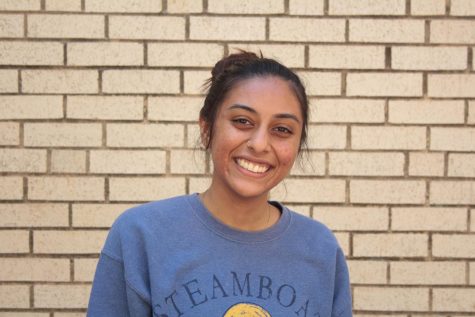At twelve years old, senior Sadie Thomas danced onstage.
Under the glow of the spotlights, she was completely immersed in her routine. It didn’t matter that she’d been in a battle with her body since 2015. It didn’t matter that she needed expensive medication to survive, or that she often felt out of control of how her body functioned — her hard work had brought her here.
But in the waiting room adjacent to the stage, her babysitter checked Sadie’s blood sugar. A reading of over 250 could make her lose consciousness.
Sadie was at 400.
When she stepped away for a break, they realized that her insulin pump was malfunctioning, and a flurry of panic ensued. Her mom, frantically texting the babysitter. Worries about going into diabetic ketoacidosis: headaches and nausea before losing consciousness. Her sugar level, climbing, climbing, eventually hitting a whopping 700.
She remembered stories of other diabetics whose bodies had rebelled. The risk of passing out and dying on the spot.
But stomaching her fear, she went back onstage to finish.
After the recital, they got Sadie’s pump to start working, and the diabetes was once again under her control. Physically and emotionally exhausted, they drove home.
***
As a typeone diabetic, Sadie’s life is defined by a number.
Unlike type two diabetes, type one diabetes isn’t caused by eating habits. It’s a chronic illness where the pancreas doesn’t make enough insulin for the body. The lack of insulin causes abnormally high sugar levels — to stay healthy, diabetics need to be constantly checking their sugar level.
The glucose monitor stuck to Sadie’s arm is a constant way to check her blood sugar without pricking her finger. Itsends the number to her phone, so she’s always checking it.
Ideally, the number should range between 100 and 110. Too high is 150, too low is 70, and 250 can make her brain stop working.
Either side of this range is not ideal. Low blood sugar and too much insulin can cause seizures. If nobody is around to help, the seizing can lead to permanent brain damage. But too high of a sugar level could cause diabetic ketoacidosis.
“I’ve never had either of those things happen to me because I keep a very tight control on my blood sugar,” Sadie said. “But it happens.”
Sadie was diagnosed with type one diabetes at age 10.
Her diagnosis came when her brother was also battling a medical condition. While her brother got treatment at the hospital, she and her younger sister moved in with her grandparents.
Living with her grandmother, who’s a nurse, could be frustrating. While her grandmother pushed her to follow the hospital’s instructions exactly, Sadie tried to figure out what worked for her body.
“Because it’s a lifelong illness, you kind of get to know your body,” Sadie said. “And every diabetic is different. So with the amount of decisions that you make every day, it could be different from the exact protocol that the hospital will tell you to follow.”
Sadie’s sister, freshman Gwen Thomas, had a harder time accepting Sadie’s illness.
She barely knew what was going on. As a kid who suddenly had so much attention taken off her and put on Sadie, she felt invisible.
“I remember being really nervous for her,” Gwen said.
When the girls went to school, they faced criticism for Sadie’s diabetes — even though it was nobody’s fault.
“People figured out that she had diabetes,” Gwen said. “They were judging my family, and like my parents for not taking care of her when she was younger.”
But Sadie educated herself on her illness. Before she left the hospital, she learned how to give herself insulin shots.
Sadie learned to stick to a diet that would regulate her sugar level. She grew up with her eye on that number.
“With me, I just grew up like a flash,” Sadie said, “It was like, if anything happened where I just needed to be on my own, I would have been able to.”
***
Her insulin pump is the size of an iPod. She inputs the amount of insulin she needs, and it reads her blood sugar and it transmits insulin through a white tube. She charges it every two days.
Even though she eats and takes her insulin responsibly, hormones or sickness can still cause abnormal sugar levels.
When her sugar soars beyond control, Sadie can’t focus anymore. She stays home from school for days at a time, falling behind on work and foregoing social obligations.
“Being at school, I’m meant to sit there and focus on what’s happening,” Sadie said. “And there’s no way for me to focus on school when my blood sugar’s not right. My brain just doesn’t work the same.”
***
Sadie was sitting in her car with her boyfriend, about to drive him home, when she got what she initially thought was a panic attack. Her head suddenly felt light. She was dizzy, nervous.
“I started freaking out and I wasn’t sure why,” Sadie said.
When her boyfriend checked her blood sugar, it was at 40. They switched seats, and he drove to a gas station to buy her juice. While she sat waiting in the passenger seat, her blood sugar dropped to 30. Her parents were 20 minutes away.
“It was really scary in the moment,” Sadie said.
He came back. She drank the juice, and he drove her home. She felt like an inconvenience, but driving with low sugar would risk her own life and others’.
“That’s a big deal when I have days where I’m not able to drive,” Sadie said. “Because at that point, it’s not a negotiation. It’s not a question. I can’t drive.”
Since her boyfriend didn’t have a car yet, her dad had to drive him home. Again, her diabetes had ruined what was supposed to be a fun night. “Sometimes it feels like there’s not a different way out than to manipulate your diabetes — Sadie Thomas, 12
Body dysmorphia as a teenager is difficult. Feeling too big or too small, and finding a diet that works is difficult. But Sadie says that a food-based disease only makes body dysmorphia harder to navigate.
She says that a lot of it stemmed from diabetes.
“You immediately think, ‘Oh, she can’t have sugar. She ate too much sugar. So now she’s overweight,’” Sadie said.
From ages 10-16, guilt surrounded eating or feeling hungry.
You’re eating too much. You’re going to get overweight, and everyone’s going to make fun of you.
But when she let bad thoughts win, she still felt guilty — what if her blood sugar dropped too low? She was being irresponsible.
“I had no idea how to turn those thoughts off in my head,” Sadie said.
She went entire days without eating, so her blood sugar would fluctuate.
“A lot of days, I would wake up, and I would feel like, if I don’t eat anything, then I won’t need insulin, and all my blood sugar will stay stable,” Sadie said.
Diabetics who want to lose weight may feel out of control because they can’t do many diets. So some find other ways to lose fat.
When Sadie attended a camp for people with diabetes, she had a mentor who would let her blood sugar rise too high on purpose, because her body’s extremely high sugar levels made her burn fat.
“Sometimes it feels like there’s not a different way out than to manipulate your diabetes,” Sadie said.
She was getting smaller, but she was burning necessary muscle and harming her organs.
“Trying to just figure out how to lose weight the fastest without regard to your muscle and the organs in your body is very dangerous,” Sadie said.
The people in her life encouraged her through her fluctuating body image. Gwen says that the hardships caused by Sadie’s diabetes brought the family together to support her.
“That’s really important to my family, because we’re all so close because of the hospital and all the illness,” Gwen said. “So she does lean back on us a lot. And we’re always here for her.”
Her mom helps her keep things in perspective, reminding her that her insecurity will wear off as she gets older.
“If you’re struggling with being overweight, there are ways to fix that without damaging your body,” Sadie said.
***
Diabetes is incurable. But while she keeps up to date with the latest diabetes research, Sadie is coming to terms with potentially having to monitor her number for the rest of her life.
“Eventually, I hope that they come up with a cure while I’m still living,” Sadie said. “But we don’t know that for sure, so we’ll see.”
In the meantime, she’s found a college roommate who also has diabetes. She looks forward to having this support through nursing school.
“We’re already kind of friends, so we know each other and can watch over each other,” Sadie said. “That’ll kind of jumpstart being able to live without my parents.”
Even though she’s accepted her illness, she understands the pain of having not done so. But she encourages those in the same position to keep taking care of themselves.
“Sure, rebel for a minute,” Sadie said. “Take fifteen minutes and sit on the couch and eat Sour Patch Kids and don’t pay attention to it. But then get back on it. Give your insulin. Do it because you’re going to feel better in the end.”
More than anything, she understands the importance of having people help you through it.
“Find somebody who will empathize with you, because sitting in it alone will make you feel a lot worse,” Sadie said.
Her friends and family are the reason she knows she’ll be okay.
“I’m not worried at all,” Sadie said. “Because I have a good support system around me, and people who would help me if I were to need anything.”







